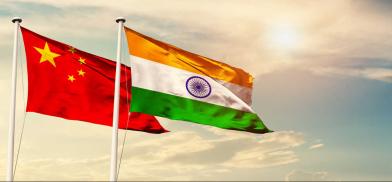Indian policy towards China needs to change: offence is the best form of defence
During the military commanders' meeting, the Indian side asked for the PLA to move back from all the “friction points”, which is a euphemism for "intrusions" used by India to avoid acknowledging it has lost control of some 1,000 sq km of territory during the 2020 Chinese aggression. For the same reason, India keeps asking of more military-to-military talks, with each round continuing 12-13 hours without any progress, writes Lt Gen P.C. Katoch (retd) for South Asia Monitor

Three news items relating to China are prominent in the media. First, China’s debt crisis in the housing sector amounting to about $1 trillion is witnessing protests from home buyers unable to repay the loans. China has asked banks to give more loans to the concerned, irrespective of whether they can repay or not. Protests don’t matter to the ruthless regime of China’s Communist Party (CCP) which will simply crush protesters. China’s growth rate has slowed down like most of the world but the CCP will prevail even if it has to print more money. Moreover, America’s economic terrorism in selectively blocking SWIFT is boosting the use of the yen.
Second, is the news about the rift within the CCP and speculation that President Xi Jinping may not get a third term in the forthcoming 20th Congress of the CCP, and that Prime Minister Li Keqiang is becoming stronger. But Xi is too shrewd; he will in all probability maneuver his way around whatever the rift in the party and the problems facing China. In fact, the US bungling in Ukraine and Washington’s reaffirmation of the One China policy favours Xi to focus more on China. India must acknowledge that whether Xi or Li, the CCP’s aggressive attitude towards India is unlikely to change.
Third, is the India-China standoff in Eastern Ladakh from April-May 2020 together with mobilization of thousands of People's Liberation Army (PLA) troops and the Indian military along the entire border. Did India provide China the incentive for this? Apparently so. When the Union Territory of Ladakh was established by India as part of reorganization of Jammu and Kashmir in 2019, Home Minister Amit Shah said in Parliament that Aksai Chin is a part of Ladakh which India will take. China took note and hence the deepest Chinese intrusion (19 km) made during 2020 is in Depsang, which can be a springboard for taking Aksai Chin.
Political bragging
Also, political statements from India like “we too keep going across” was used by China to brand India the aggressor from day one. Ironically, our politicians don’t understand the costs of political bragging to impress audiences at home. Similarly, the much-publicized inauguration of the Tawaghat-Lipulekh Pass enroute to Kailash-Mansarovar Yatra by Defence Minister Rajnath Singh led to Nepal claiming areas in India; the dispute is yet to be settled.
The 16th round of military-to-military talks between India and China held on July 17, 2022 in Ladakh were as inconclusive as the preceding two rounds. As on earlier occasions, the joint statement used flowery diplomatic language like commitment to maintain peace and tranquility; this means nothing. The Indian side was hoping that China would agree to go back from Patrolling Point (PP) 15, even as China not agreeing to it was expected since its location in the Kungrang Nullah area provides an access route to Kongka La -- a key pass leading into the Aksai Chin hinterland and beyond.
China reportedly made a counter offer with regard to PP 15, which has not been made public. Possibly this would be for establishing a few km long buffer zone, implying that Indian troops retreat further in their own territory.
Border issue needs political resolution
During the military commanders' meeting, the Indian side asked for the PLA to move back from all the “friction points”, which is a euphemism for "intrusions" used by India to avoid acknowledging it has lost control of some 1,000 sq km of territory during the 2020 Chinese aggression. For the same reason, India keeps asking of more military-to-military talks, with each round continuing 12-13 hours without any progress.
The border issue needs to be resolved at the political and diplomatic level. China is unlikely to move back, having intruded into Indian territory even west of its 1959 claim line which India never acknowledged. Apparently, China is treating these intrusions as fait accompli.
Unfortunately, Indian policy makers fail to acknowledge that offence is the best form of defense and history shows that whenever a stand was taken against China, the PLA retreated, examples being at Nathu La in 1967 and at Sumdorong Chu in 1987. But our policy makers forced the military into reverse gear by vacating the strategic Kailash Range within Indian territory, which overlooks some PLA positions and can be used for further operations. With China refusing to vacate its intrusions especially in Depsang and Demchok, there is no reason why we should not reoccupy the Kailash Range but this requires political courage.
China sitting pretty
China is sitting pretty having consolidated its positions in the intrusion areas and two bridges on the Pangong Tso that boosts PLA’s offensive capabilities. Besides, Beijing is more than happy with exports to India going up despite the standoff.
Australia’s former Prime Minister Kevin Rudd feels that Xi will resolve China’s border with India after the 20th Congress of the CCP. But the question is what resolution Xi has in mind, given Beijing’s insatiable hunger for territory, minerals and water? Xi recently visited Xinjiang and Chinese fighter jets are beginning to fly close to the Line of Actual Control (LAC) with India. Clearly, the signs are not encouraging.
(The author is an Indian Army veteran. Views expressed are personal.)









Post a Comment